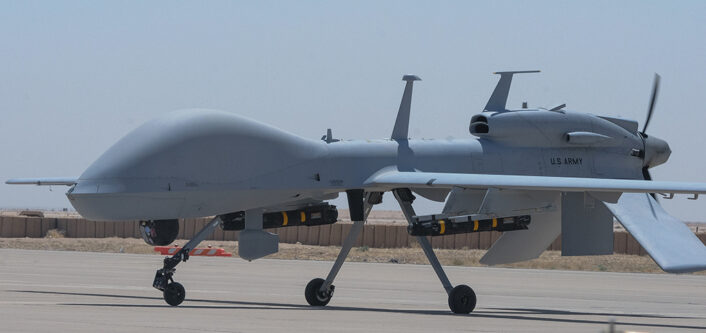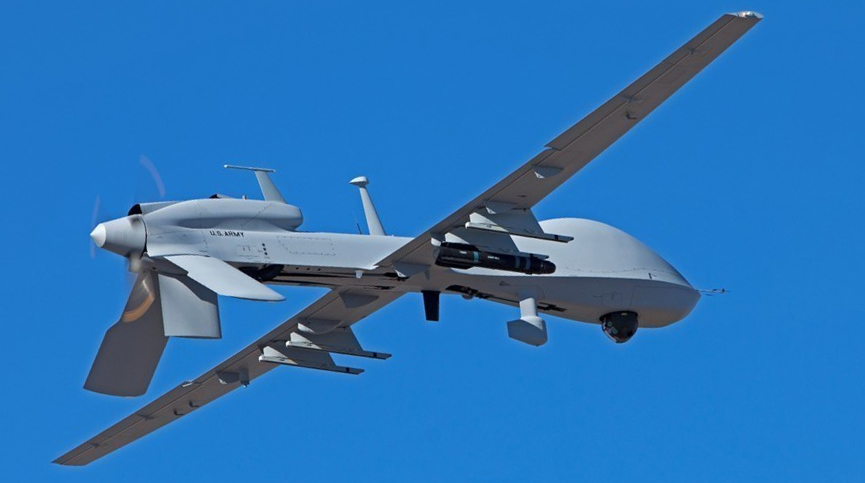The White House has plans to sell Ukraine four MQ-1C Gray Eagle drones to help Kyiv in the war against Russia.
The Biden administration plans to sell Ukraine four MQ-1C Gray Eagle drones that can be armed with AGM-114 Hellfire missiles for battlefield use against Russia, three people familiar with the situation said according to an exclusive Reuters report posted on June 1, 2022.
“The sale of the General Atomics-made drones could still be blocked by Congress, the sources said, adding that there is also a risk of a last minute policy reversal that could scuttle the plan, which has been under review at the Pentagon for several weeks,” the report said.
Ukraine has made extensive use of several smaller armed UCAVs (Unmanned Combat Aerial Vehicles), with the Bayraktar TB2 medium altitude long endurance (MALE) unmanned combat aerial vehicle (UCAV) of the Ukrainian forces emerging as the real star of the air war, inflicting Russian forces heavy losses, some of those caught on tape and circulated online. As explained commenting the footage shot by TB2 taking out a Tor mobile short-range surface-to-air missile system (aka SA-15 “Gauntlet”) or supporting the air strike of two Ukrainian Su-27 on Russian facilities on the famous Snake Island in the Black Sea, all the videos (along with the accounts that TB2s allegedly helped decoy the Moskva’s defences) prove what a drone with a long-range FLIR and a wide array of weapons can do, in a “direct” or “indirect” way, in a modern conflict like the one in Ukraine.
But the Gray Eagle are larger and have a higher MTOW (Maximum Take Off Weight): it can carry a wide array of sensors, both internally or in external pods, and, up to four AGM-114 missiles, each being double the weight than the Turkish MAM-L munitions carried by the TB2.

The Gray Eagles are made by General Atomics and are currently used by the U.S. Army, with combat experience in Iraq and Afghanistan. They have also been used in the AFRICOM area of operation as recently as 2021. As explained in a previous article about an emergency landing of a US Army MQ-1C in Niger:
The Gray Eagle is an advanced derivative of the Predator specialized in providing direct operation control by Army field commanders. It can fly Reconnaissance, Surveillance, and Target Acquisition (RSTA); convoy protection; Improvised Explosive Device (IED) detection as well as providing live aerial imagery to ground patrols carrying also PGMs (Precision Guided Munitions): in other words, it can support a wide variety of missions including attack, assault, reconnaissance, infiltration and exfiltration, and any kind of known or unknown special operations you may imagine.
The type has been flying over the U.S. hot spots around the world for quite some time now (including Iraq, where one was lost in 2015). Dealing with Niger, armed U.S. drones have been operating out of Niger Air Base 201, located around 5 km southeast of Agadez, since 2019, thanks to a bilateral agreement between the U.S. and Nigerien governments. Previously, U.S. remotely piloted vehicles, as well as other manned ISR (Intelligence Surveillance Reconnaissance) aircraft had been operating out of Niger’s capital, Niamey.
How they will be really employed and, how long training on the new weapons system will take, are still open questions; however, if confirmed, the sale would would expand the capabilities of the Ukrainian drone fleet, making it even more capable of striking Russian forces on the battlefield.













